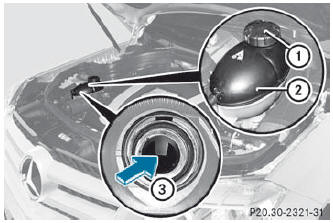 Mercedes-Benz GLK-Class: Checking the coolant level
Mercedes-Benz GLK-Class: Checking the coolant level
Only check the coolant level when the vehicle is on a level surface and the engine has cooled down.
- Turn the SmartKey to position 2 () in the ignition lock. On vehicles with KEYLESS-GO, press the Start/Stop button twice ().
- Check the coolant temperature display in the instrument cluster. The coolant temperature must be below 158 F (70 C).
![]() WARNING
WARNING
In order to avoid any potentially serious burns:
- use extreme caution when opening the hood if there are any signs of steam or coolant leaking from the cooling system, or if the coolant temperature display indicates that the coolant is overheated.
- do not remove the pressure cap on the coolant reservoir if the coolant temperature is above 158 ‡ (70 †). Allow the engine to cool down before removing the cap. The coolant reservoir contains hot fluid and is under pressure.
- using a rag, slowly turn the cap approximately 1/2 turn to relieve excess pressure. If opened immediately, scalding hot fluid and steam will be blown out under pressure.
- do not spill antifreeze on hot engine parts. Antifreeze contains ethylene glycol which may burn if it comes into contact with hot engine parts.

- Slowly turn cap 1 half a turn counterclockwise and allow excess pressure to escape.
- Turn cap 1 further counter-clockwise and remove it. If the coolant is at the level of marker bar 3 in the filler neck when cold, there is enough coolant in coolant expansion tank 2. If the coolant is approximately 0.6 in (1.5 cm) above marker bar 3 in the filler neck when warm, there is enough coolant in coolant expansion tank 2.
- If necessary, add coolant that has been tested and approved by Mercedes-Benz.
- Replace cap 1 and turn it clockwise as far as it will go.
For further information on coolant, see ().
 Windshield washer system and headlamp cleaning system
Windshield washer system and headlamp cleaning system
The washer fluid reservoir is used for both the windshield washer system and
the headlamp cleaning system.
Vehicle components and their service products must match. You should, therefore,
only ...
See also:
Rear window defroster
The rear defroster control is located on the climate control panel and
works to clear the rear window of fog and thin ice.
The engine must be running to operate the rear window defroster.
Press ...
Trailer towing tips
In order to gain skill and an understanding of the
vehicle’s behavior, you should practice turning,
stopping and backing up in an area which is free
from traffic. Steering stability, and braki ...
USB Flash Memory Device Error Messages
If you see an error message on the
screen while playing a USB flash
memory device, find the solution in
the chart to the right. If you cannot
clear the error message, take your
vehicle to yo ...

